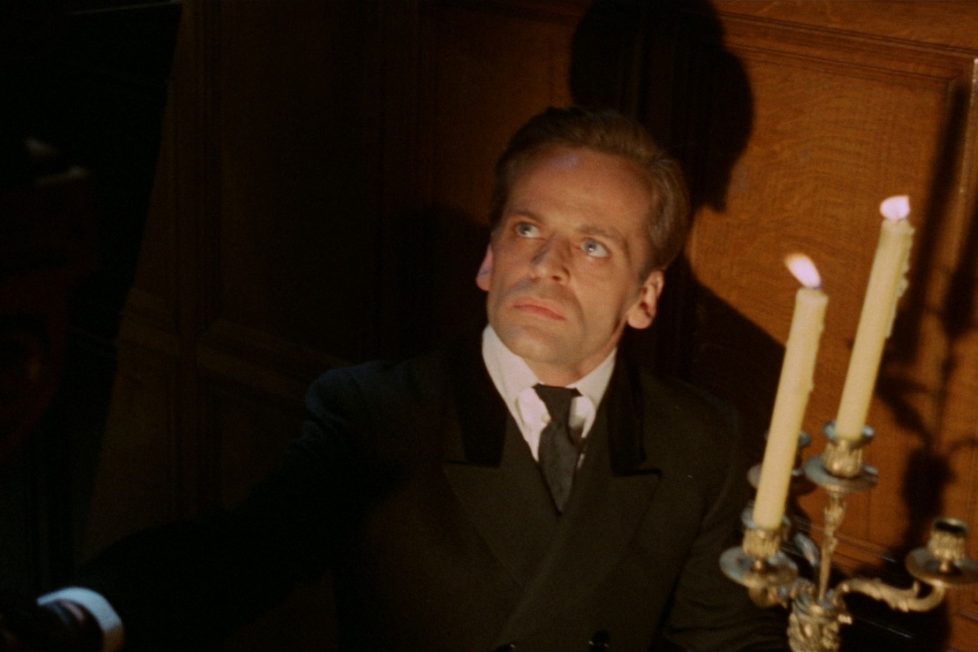DOUBLE FACE (1969)
The murder of a millionaire's lesbian wife sucks him into the sleazy underbelly of 1960s London...

The murder of a millionaire's lesbian wife sucks him into the sleazy underbelly of 1960s London...


Riccardo Freda is an Italian film director whose long and patchy career has earned him a cult following for his genre offerings. He’d already written a dozen or so screenplays before he stepped up as director for historical adventure drama Don Cesare di Bazan (1942). He was soon a hard-working writer-director, turning his hand to comedies and melodramas, or anything that promised a pay cheque. His first notable success was Black Eagle (1946) for Dino DeLaurentiis, along with its sequel Revenge of the Black Eagle (1951).
But the movie that earned the respect of genre fans, and aficionados of Italian cinema alike, was I Vampiri (1957). Rather than taking it on as an assignment, it was Freda who initiated the project, apparently only securing a budget from Titanus Studios after writing it in a single day and agreeing to complete filming within two weeks! It bucked the trend, being the first Italian horror to be made since the silent era, and has since been hailed as the progenitor of the Italian Gothic renaissance that became synonymous with Mario Bava. Now, that’s not surprising as Bava was the cinematographer for I Vampiri and, when Freda fell-out with Titanus, Bava was left to fill in as director to ensure the film was completed.
For me, The Horrible Dr Hichcock (1962) stands out as Freda’s most interesting picture. Perhaps that’s down to the quality of the writing, in the hands of the hugely prolific Ernesto Gastaldi (who also wrote of most of my favourite gialli), or maybe it’s the presence of Barbara Steele in the lead role. Now that’s a genre gem ripe for reassessment, crying out for a loving restoration and UK Blu-ray release…
For now, we’ll be grateful that Double Face (1969), directed by Freda under his favourite pseudonym of ‘Robert Hampton’, has been newly restored by Arrow Video. It comes hot on the heels of their Blu-ray release of The Iguana with the Tongue of Fire (1971). Both are gleaned from the tail-end of his career and neither would be getting such attention if it wasn’t for the current resurgence of the giallo. Unfortunately, neither are particularly shining examples of the genre…
Double Face is perhaps the more interesting of the two because, being an Italian-German co-production, it manages to bridge between the genres of giallo and krimi, which adds some novelty. But, much like Iguana, the plot doesn’t bear scrutiny, and whilst there’s solid cinematography by Gábor Pogány, there are plenty of shoddy shots that seem to have been scavenged from the cutting room floor to pad out the runtime. However, it’s entertaining enough and Freda manages to maintain interest right up to the surprising dénouement. It’s only a surprise because he’s miserly with dishing out the clues, however, not because there’s any clever cinematic sleight of hand going on.
Its main appeal lies in the atmosphere evoked that hovers somewhere between noir pastiche and sleazy Eurotrash. It feels more like a giallo (Italian pulp films typified by grand guignol murder set-pieces and audacious puzzle-plots) than a krimi (crime thrillers in the style of Edgar Wallace mysteries often featuring gangs, blackmail, or mad criminal masterminds), but it’s not comfortable in either genre. There’s not enough style and cleverly contrived twists to hold its own against the typical giallo. And there’s not enough madness and, well criminal mayhem, to sit alongside a classic krimi. It ends up feeling more like a blackmail thriller… but one that never really gets around to the blackmail plot. It has some nice noirish stylings but doesn’t show us anything as clever or hard-boiled as countless proper noirs already did in the 1940s and ’50s.
It starts well enough with a nighttime car chase ending with a Gerry Anderson standard model shot as a train ploughs into a white Rolls Royce, and then as the car burns Klaus Kinski looks on from the passenger seat of a police car and his voice-over proclaims, “It ended so tragically and yet it had been planned down to the minutest detail…” The story is then told as a circular narrative that, as it unfolds, makes it clear that it wasn’t terrifically well planned after all! Or if it was, it wasn’t clearly revealed how. At this point, we don’t know who was in the burning car, so that’s the hook to keep us guessing. Except, we know it wasn’t John Alexander (Kinski).
We then get some of his backstory, as we realise Kinski’s been cast against type as a rich if fairly boring businessman, who comes home early one day to find his wife Helen (Margaret Lee) in the bath listening to smoochy French songs with another young woman, Liz (Annabella Incontrera). Clearly, their marriage is on the rocks, but his wife seems to take some measure of pleasure in denying him a divorce and pointing out that she owns 90% of the shares in a firm owned by her father, Mr Brown (Sydney Chaplin), who’s also Alexander’s boss.
She decides to go away for a while to figure things out, saying she intends to drive to Liverpool and then onto Scotland. It’s only at that point I realised the film was set in England because some of the location shooting certainly isn’t. Freda makes up for this later on with an extended sequence of the out-of-focus Kinski wandering from bar to bar through the neon-lit night streets of late-1960s Soho. I’ll leave it for you to decide if it’s so dark and poorly focussed for artistic reasons or due to technical error!
One thing this film has going for it is a fabulous catalogue of classic cars. There’s the aforementioned Roller, Alexander drives a red Aston Martin or a classic white Jaguar, and Helen heads north in her silver E-Type Jag, but not before a mysterious black-gloved hand has attached a time bomb to its chassis. There we have an early appearance of what becomes a favourite giallo trope: the black-gloved killer. Oh, and the score is a stand-out feature, though sometimes obtrusive. It was written by Nora Orlandi, under the name of Joan Christian, an innovator of Italian film music. She’s also the smoochy French singer of the recurring theme song, which she performs under another pseudonym of Silvie St. Laurent. I know her best for her score for The Strange Vice of Mrs Wardh (1971), an essential giallo, and there’s plenty more about her in the bonus material included with this new Blu-ray.
The other major draw is Klaus Kinski in an early starring role after more than 60 bit-parts and supporting roles, including For a Few Dollars More (1965) and Doctor Zhivago (1965), as well as plenty of German krimi films such as the evocatively named Dead Eyes of London (1961), Secret of the Red Orchid (1962), Mark of the Tortoise (1964), and Creature with the Blue Hand (1967), to name but a few. Nobody plays mad better than Kinski and whenever his expressive face is on screen, it’s hard to look away. But here he’s atypically subdued and at times his vulnerability elicits sympathy, albeit short-lived as he also gets meaner as his desperation builds.
On its release in Germany, the promoters lied and tried to capitalise on Kinski’s krimi credentials by claiming the story was based on Edgar Wallace’s 1924 novel The Face in the Night. Lucio Fulci actually wrote the original story, in parallel with the script for his own film, One on Top of the Other (1969), in which he revisits the central theme of a dead-ringer for a dead wife. In Double Face, the lookalike is seen in a ‘stag film’, whereas in One on Top of the Other she’s a stripper.
Fulci was happy to distance himself from the film and shared the screenwriting credit with a handful of others including Freda, who Fulci claimed “completely crushed it down to a pulp… he just didn’t care anymore.” He does seem to have a point as it really reads like a film project, started with pride, that just fell apart—through lack of budget or tight scheduling—and ended up as a mix ranging from fine segments shot in beautiful interiors with an almost Gothic sensibility, to appalling blue screen embarrassments and shots that really shouldn’t have made it into the final cut of any film with a self-respecting director at the helm.
If you’re prepared to forgive its considerable short-comings and get into the spirit of the story, there’s some fun to be had. Things move along in fits and starts and there are some exciting, even slightly naughty set pieces. There’s a motorbike jousting party, where the riders tug items of clothing off attractive young Go-go dancing chicks in a terribly cliched version of a wild ’60s party… the fantasy-fulfilling young ‘teenage’ runaway, Christine (Christiane Krüger), that Mr Alexander finds ‘making free’ with his mansion in his absence…. the incriminating 16mm ‘stag film’ that seems to be re-edited every time Alexander tries to convince others his wife may still be alive, but instead convinces them he’s slowly losing it…. and the rain-coated, dogged Inspector Stevens (Günther Stoll), who manages to figure things out and bring it all to a climax of confession in a cathedral.
It didn’t do well at any box office, with a staggered release in different territories. It was first shown in West Germany as Das Gesicht im Dunkeln/The Face in the Dark, then released in Italy as A Doppia Faccia/Double Face. It didn’t find a distributor in France until 1973 when it was promoted on the strength of its lesbian theme as Liz et Helen, and when that didn’t do well enough it was actually recut with additional ‘hard-inserts’ involving footage shot with body-doubles and shown in adult cinemas as Chaleur et Jouissance/Heat and Pleasure. It eventually got a VHS release in the USA during the 1990s, as Puzzle of Horrors.
Now, finally, a definitive ‘Director’s Cut’ has been consolidated with this brand new 2K restoration of the full-length Italian version of the film, transferred from the original 35mm camera negative. Not only that, Arrow has assembled their usual package of excellent, specially shot, extras that are more of a selling point to genre aficionados than the main feature.
director: Riccardo Freda.
writers: Riccardo Freda & Paul Hengge (story by Lucio Fulci, Romano Migliorini & Giambattista Mussetto).
starring: Klaus Kinski, Christiane Krüger, Günther Stoll & Annabella Incontrera.

